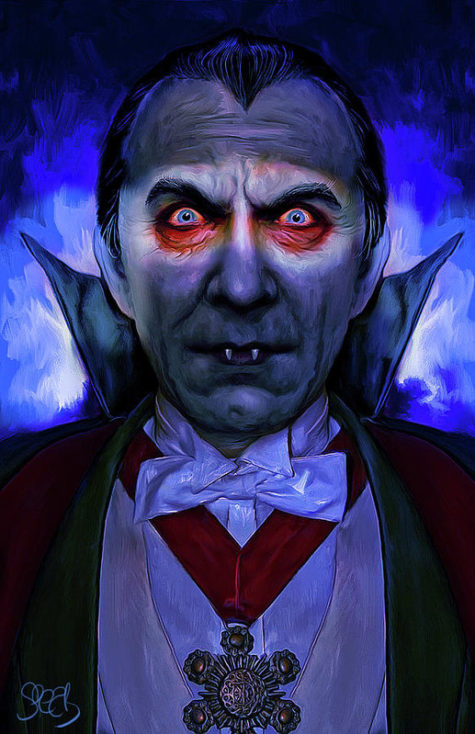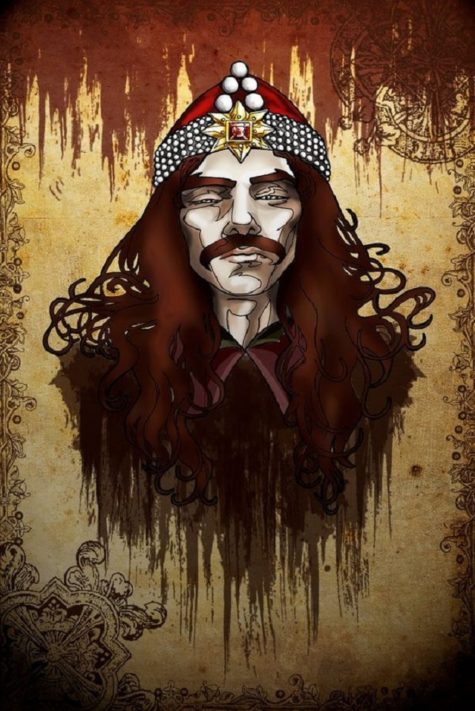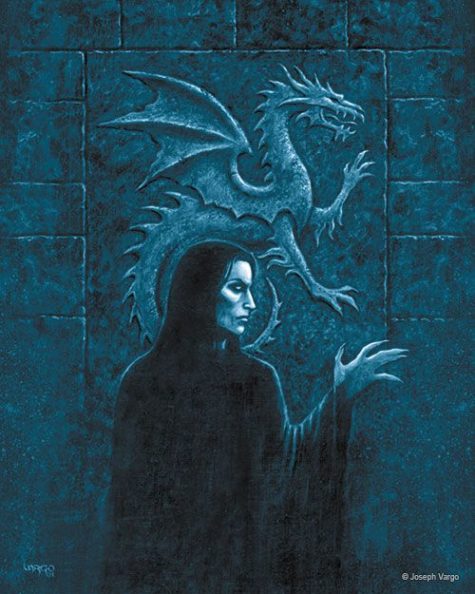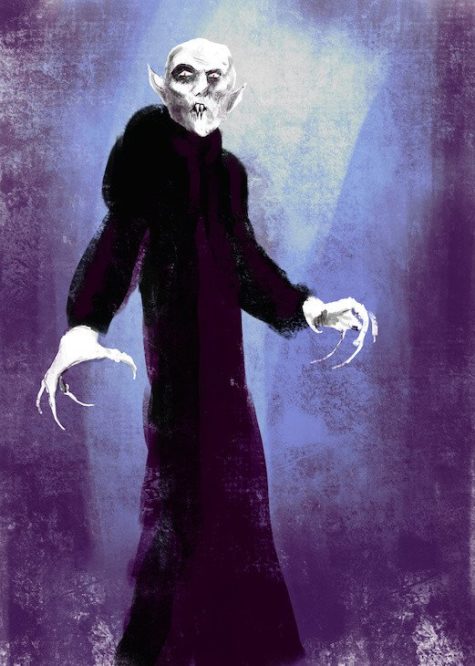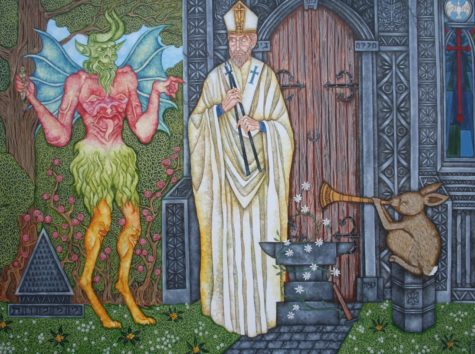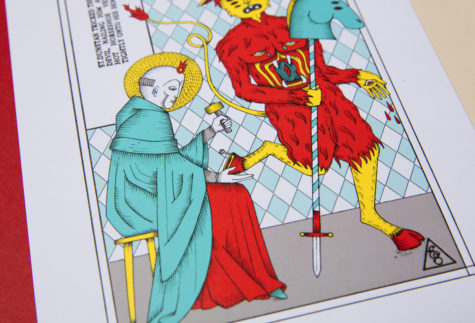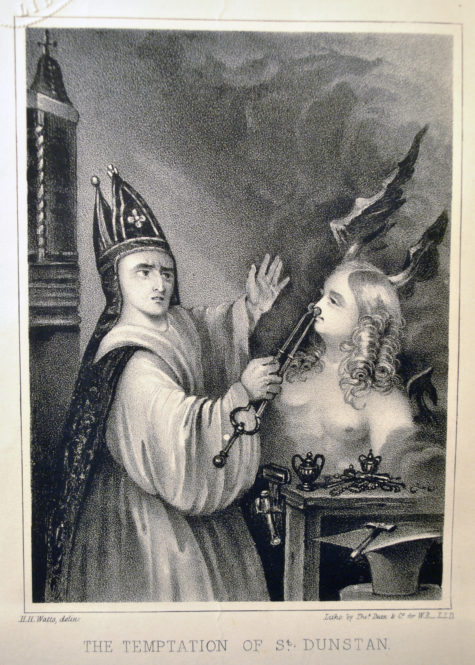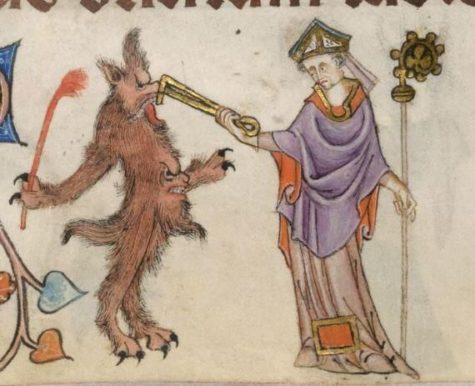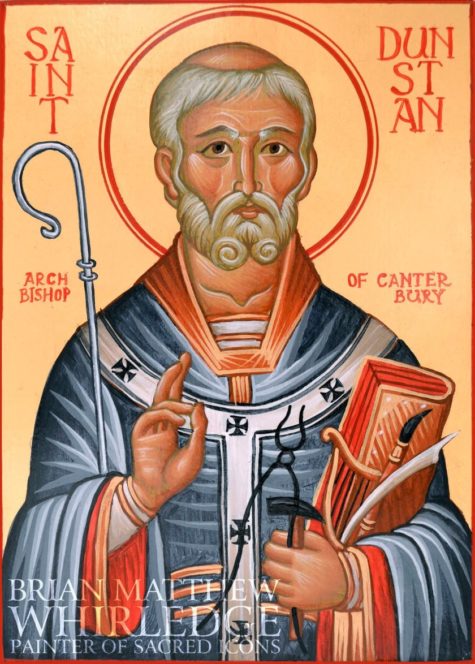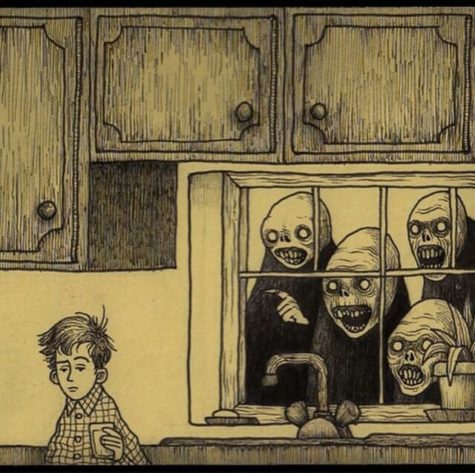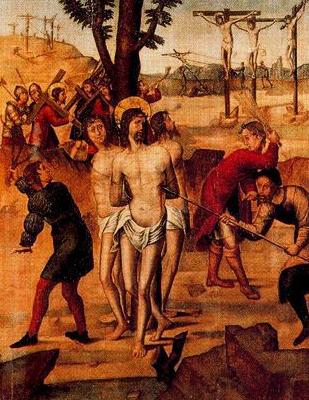Monthly Archives: May 2019
May 26 is World Dracula Day which commemorates Bram Stoker’s Gothic horror novel Dracula, which was first published on May 26 in 1897, by Archibald Constable and Company in Britain. It sold for six shillings and came bound in yellow cloth with red lettering. It was first printed in the United States two years later, by Doubleday & McClure of New York City. Although not the first novel about vampires, it became a model for the genre, and laid the foundation for future vampire stories, with its introduction of the character Count Dracula.
The quintessential vampire, Count Dracula has inspired tens of films and stories the world over, not to mention the virtual immortality of the character during as a beloved Halloween character. For all of these reasons, it’s undeniable that this icon of horror more than deserves his own little holiday so the world can show its appreciation for his contributions to the worlds of cinema and literature over the centuries. So put on your fangs, and let’s sink out teeth right into this, shall we?
About The Book
The book follows (spoiler alert!) an English lawyer named Jonathan Harker as he travels to Transylvania to meet Count Dracula at his castle, Castle Dracula. To Harker, Dracula appears pale and off-kilter. The strangeness of Dracula is more apparent after he lunges at Harker’s throat after Harker cuts himself while shaving. Harker eventually finds out that Dracula is a vampire who needs to drink human blood to survive. Afterward, Dracula locks Harker in the castle and flees to England with 50 boxes of dirt (it is believed he needs dirt from his home country to stay healthy). As Dracula heads to England to search for new blood, Harker eventually escapes from the castle.
Meanwhile, Mina, Harker’s fiancée, is visiting her friend Lucy in England. One night, Mina finds Lucy sleepwalking by a graveyard. Mina believes she sees a creature hovering over Lucy for a moment, and then notices two red marks on Lucy’s neck. Lucy becomes sick over the next few days and is then cared for by a Dr. Seward and by Dr. Abraham Van Helsing, before eventually dying. Afterward, strange reports begin surfacing that a creature has been attacking children in the area.
Jonathan Harker and Mina are reunited and married. Harker tells Dr. Helsing about his experience with Dracula, and Helsing then believes Lucy contracted vampirism from him and is the one attacking children. They dig up her corpse, cut off her head, put a stake through her heart, and stuff her mouth with garlic. They then turn their focus to Dracula and try to destroy his boxes of dirt. He escapes back to Transylvania, where they find him buried in the last box of dirt. They cut off his head and stab him through the heart, causing him to collapse into dust.
The Origins Of Dracula
Stoker spent years researching vampires before writing Dracula. During that time, he was particularly influenced by “Transylvanian Superstitions,” an essay by Emily Gerard that was published in 1885. Stoker worked at the Lyceum Theatre in London from 1878 to 1898. The theater was headed by Henry Irving, who Stoker based Dracula’s mannerisms on. It was even Stoker’s hope that Irving would play Dracula in a stage adaptation, but it did not happen.
According to one theory, Prince Vlad III of Wallachia (Romania) was the real-life inspiration behind Stoker’s gothic horror novel. An extremely cruel and merciless ruler, Vlad earned the nickname “Vlad the Impaler” for the many ways he tortured his opponents as well as people who betrayed him when they were captured. As can be guessed from his nickname, impaling was his favorite method of execution, and it is thought that he killed up to 100,000 people during his reign, and was infamous for the “forests” of impaled victims he left behind when he won a battle. One unsubstantiated account says that he dipped bread in his victims’ blood and ate it in front of them as they died on stakes.
Born in Transylvania in the fifteenth century, he was also called Drăculea, which means “Son of Dracul.” Indeed, his father was known as Dracul, a name that derived from the knightly order he belonged to—the Order of the Dragon (the Latin word draco means dragon). In modern Romanian, drac means “devil.”
It is believed that Stoker picked the name Dracula after learning this more modern translation. Some believe that the only connection between Vlad III and Dracula are their names. The connection of his character with vampirism was made by Bram Stoker around the 1890’s, and has become a permanent element of pop culture since then.
What does it mean?
Dracula has been interpreted in numerous ways. Some have interpreted the story as an allegory of the fear that western Europeans had of eastern Europeans coming into their area. Hence, the story of someone coming from Transylvania—in Romania—to London and wreaking havoc on its residents. This theme appeared in other novels of the time.
Some have seen the book as a reaction to the conservative and patriarchal norms of the Victorian period, and as an exploration of suppressed sexual desire. Some also have seen the book as being about the relationship between the past and future, with Dracula symbolizing a primitive past that challenges modernity.
The Historical Vampire
The concept of vampirism dates back thousands of years. The ancient Greeks, Hebrews, Egyptians and Babylonians all had legends telling hair-raising tales of demon-like undead creatures that lived off of the blood of the living.
Tales of the undead consuming the blood or flesh of living beings have been found in nearly every culture around the world for many centuries. Today we know these entities predominantly as vampires, but in ancient times, the term vampire did not exist; blood drinking and similar activities were attributed to demons or spirits who would eat flesh and drink blood; even the devil was considered synonymous with the vampire.
Almost every nation has associated blood drinking with some kind of revenant or demon, from the ghouls of Arabia to the goddess Sekhmet of Egypt. Indeed, some of these legends could have given rise to the European folklore, though they are not strictly considered vampires by historians when using today’s definitions.
Hebrews, ancient Greeks, and Romans had tales of demonic entities and blood-drinking spirits which are considered precursors to modern vampires. Despite the occurrence of vampire-like creatures in these ancient civilizations, the folklore for the entity we know today as the vampire originates almost exclusively from early 18th-century Southeastern Europe, particularly Transylvania as verbal traditions of many ethnic groups of the region were recorded and published. In most cases, vampires are revenants of evil beings, suicide victims, or witches, but can also be created by a malevolent spirit possessing a corpse or by being bitten by a vampire itself. Belief in such legends became so rife that in some areas it caused mass hysteria and even public executions of people believed to be vampires.
In India, tales of vetalas, ghoul-like beings that inhabit corpses, are found in old Sanskrit folklore. Although most vetala legends have been compiled in the Baital Pachisi, a prominent story in the Kathasaritsagara tells of King Vikramāditya and his nightly quests to capture an elusive one. The vetala is described as an undead creature who, like the bat associated with modern-day vampirism, hangs upside down on trees found on cremation grounds and cemeteries. Pishacha, the returned spirits of evil-doers or those who died insane, also bear vampiric attributes.
The Hebrew word “Alukah” (literal translation is “leech”) is synonymous with vampirism or vampires, as is “Motetz Dam” (literally, “blood sucker”). Later vampire traditions appear among diaspora Jews in Central Europe, in particular the medieval interpretation of Lilith. In common with vampires, this version of Lilith was held to be able to transform herself into an animal, usually a cat, and charm her victims into believing that she is benevolent or irresistible. However, she and her daughters usually strangle rather than drain victims, and in the Kabbalah, she retains many attributes found in vampires.
A late 17th- or early 18th-century Kabbalah document was found in one of the Ritman library’s copies of Jean de Pauly’s translation of the Zohar. The text contains two amulets, one for male (lazakhar), the other for female (lanekevah). The invocations on the amulets mention Adam, Eve, and Lilith, Chavah Rishonah and the angels—Sanoy, Sansinoy, Smangeluf, Shmari’el, and Hasdi’el. A few lines in Yiddish are shown as dialog between the prophet Elijah and Lilith, in which she has come with a host of demons to kill the mother, take her newborn and “to drink her blood, suck her bones and eat her flesh”. She informs Elijah that she will lose power if someone uses her secret names, which she reveals at the end.
Other Jewish stories depict vampires in a more traditional way. In “The Kiss of Death”, the daughter of the demon king Ashmodai snatches the breath of a man who has betrayed her, strongly reminiscent of a fatal kiss of a vampire. A rare story found in Sefer Hasidim #1465 tells of an old vampire named Astryiah who uses her hair to drain the blood from her victims. A similar tale from the same book describes staking a witch through the heart to ensure she does not come back from the dead to haunt her enemies.
More about Vampires can be found at The Powers That Be.
How to celebrate Dracula Day
Celebrating all things Dracula why not throw a party and get your friends round for the ultimate film binge. Ideas for creating the perfect atmosphere include giving your party a Gothic feel by making sure all of your decorations are either black or blood red, the table setting is rather sophisticated, everyone is dressed elegantly and wears fangs, hanging up plenty of bat and spider web decorations, and serving plenty of blood red drinks.
It would also be perfect to watch one or more of the classic vampire movies to have been made, such as the 1958 British classic titled simply “Dracula”, and starring the incredibly impressive Christopher Lee as the aristocratic titular character. Other movie choices include “Nosferatu”, a 1922 German expressionist horror film, and “Interview with the Vampire” starring Tom Cruise, Brad Pitt, and a young Kirsten Dunst.
If it’s something more lighthearted you’re looking for, Roman Polański’s “The Fearless Vampire Killers, or Pardon Me, But Your Teeth Are in My Neck” will keep everyone entertained. Lesser known, but equally fun movies include Suck (one of my personal favorites), and Jesus Christ Vampire Hunter.
If you don’t plan on hosting a party, that does not mean you have to miss out on Dracula day—take the time to delve into the world created by Bran Stoker in his acclaimed novel. Reading a good book has never hurt anyone, and in the era social media’s 140-character blurbs of text, it is ever more important to keep the art of literature alive.
If you’ve already read it, consider tackling Anne Rice’s “Vampire Chronicles”, a series of 11 critically acclaimed books that follow influential vampires all throughout history. Stephen King’s “Salem’s Lot”. As you can see, there is no shortage of ways to celebrate the vampires of the world this Dracula Day!
Vampire Magick:
If you get really excited about all this talk of vampires, blood, and the undead, you might even be interested in exploring spells to “become a vampire.” Alternatively, you might want to play around with some protection against vampires spells, vampire prevention spells, or even a peaceful coexistence spell. They can all be found in the Book of Shadows, and Gypsy Magick and Lore.
Sources:
Traditional weather lore has it that St. Dunstan was a great brewer who sold himself to the devil on the condition that the devil would blight the apple trees to stop the production of cider, Dunstan’s rival drink. This is said to be the cause of the wintry blast that usually comes about this time. (May 19)
Foggier yet, and colder! Piercing, searching, biting cold. If the good Saint Dunstan had but nipped the Evil Spirit’s nose with a touch of such weather as that, instead of using his familiar weapons, then, indeed, he would have roared to lusty purpose.
~A Christmas Carol
This piece of folklore seeks to explain the late May frosts, known as ‘Franklin Days’ in the West Country, which often hit between 17-19 or 19-21 May. The tale was apparently particularly popular in Devon in the 19th and 20th centuries and goes thus:
Dunstan had bought some barley and made some beer, which he then hoped to sell for a good price. Seeing this the Devil appeared before him and offered to blight the local apple trees with frost (the tale is presumably set in Somerset, perhaps when Dunstan is Abbot of Glastonbury). This would ensure there was no cider and so drive demand for beer. Dunstan accepted the offer but stipulated that the frost should strike from the 17-19 May.
Stories About St. Dustan and the Devil:
According to legend, St. Dunstan had a number of encounters with the devil. The most famous story, which entered popular folklore, tells how he pulled the devil by the nose with his blacksmith’s tongs.
The story goes that while he was living as a hermit in a cell at Glastonbury, he occupied himself with various crafts, including metalwork. Against the old church of St Mary he built a small cell five feet long and two and a half feet deep. It was there that Dunstan studied, worked at his handicrafts, and played on his harp. It is at this time, according to a late 11th-century legend, that the Devil is said to have tempted Dunstan.
One day, as evening was coming on, an old man appeared at his window and asked him to make a chalice for him. Setting aside what he was working on, Dunstan agreed to the request and set to work. But as he was working his visitor began to change shape: one moment he was an old man, then a young boy, then a seductive woman.
Dunstan realized that his guest was the devil; but, pretending not to notice, he went on with his task. He took up the tongs from among his tools and laid them in the fire, waiting until they were red-hot. Then, pulling them out of the fire, he turned round and seized the devil by the nose with the tongs. The devil struggled and screamed, but Dunstan held on until at last he felt he had triumphed. Then he threw the devil out of his cell and it fled, running down the street and crying “Woe is me! What has that bald devil done to me? Look at me, a poor wretch, look how he has tortured me!”
St Dunstan stood in his ivied Tower,
Alembic, crucible, all were there;
When in came Nick to play him a trick,
In guise of a damsel passing fair.
Every one knows
How the story goes:
He took up the tongs and caught hold of his nose.
~Lay of St Dunstan, 1840
Many people heard and saw this, and the following day they came to Dunstan and asked him what had happened. He said to them, “These are the tricks of devils, who try to trap us with their snares whenever they can. But if we remain firm in the service of Christ, we can easily defeat them with his help, and they will flee from us in confusion.” And from that time he dwelt safely in his little cell.
The story was of course retold in other forms, as here in playful fashion in the South English Legendary:
þe deuel he hente bi þe nose & wel faste drou;
He twengde & ssok hure bi þe nose þat þe fur out blaste.
þe deuel wrickede here & þere & he huld euere faste,
He 3al & hupte & drou a3en & made grislich bere.
He nolde for al is bi3ete þat he hadde icome þere!
Wiþ is tonge he strok is nose & twengde him euere sore,
Forte it was wiþinne ni3te þat he ne mi3te iseo namore.
þe ssrewe was glad & bliþe inou þo he was out of is honde
And flei & gradde bi þe lift þat me hurde into al þe londe:
“Out, wat haþ þis calwe ido? wat haþ þis calwe ido?”
In þe contreie me hurde wide hou þe ssrewe gradde so.
As god þe ssrewe hadde ibeo habbe ysnut atom is nose,
He ne hi3ede namore þuderward to tilie him of þe pose.
He seized the devil by the nose and pulled very hard; he tweaked and shook him by the nose so that fire burst out. The devil wriggled here and there, and he still held fast. He yelled and hopped and pulled away and made a horrible commotion. He wished for all the world that he’d never come there! With his tongs Dunstan yanked at his nose and nipped him very sore, until night came on and he could no longer see. The villain was glad and happy indeed that he was out of his hands, and fled and cried out so it was heard all over the land: “Alas, what’s this bald one done? What’s this bald one done?” It was heard far around how the wicked one cried out. The villain had got such a good tweaking of his nose, he never hurried back there again to heal his cold!
On another occasion, when Dunstan was praying alone, the devil appeared to him in the likeness of a wolf with a gaping mouth, snarling and baring his teeth. Dunstan would not be distracted from concentration on his prayers, so the devil suddenly changed himself into a little fox, trying to get Dunstan’s attention by jumping about, contorting himself and trying to get Dunstan to laugh at him.
But, smiling a little, Dunstan only said, “You are revealing how you usually behave: by your tricks you flatter the unwary so that you can devour them. Now get out of here, wretch, since Christ, who crushed the lion and the dragon with his heel, will overcome you by his grace through me, whether you’re a wolf or a fox.”
Another legend regarding the Devil and St. Dunstan also occurred in Mayfield when the convent there had just been built. The Devil appeared to St. Dunstan and said that he was going to knock down all the houses in the village. St. Dunstan bargained with the Devil and got him to agree to leave standing any house with a horseshoe on the outside. At that time, the custom of nailing horseshoes to doors for luck wasn’t well known so the Devil agreed but St. Dunstan managed to nail a horseshoe to all the houses in the village before the Devil could get to them so the village was saved.
The Devil managed to get some measure of revenge against St. Dunstan by repeatedly setting Mayfield church, then built of wood, off its normal East-West axis, leaving St. Dunstan to repeatedly correct it. According to the lore, this was accoplished by pushing the church back into the proper east-west alignment with his shoulder!
Another church is involved with yet another St. Dunstan story. This time it is the steeple of the church in the village of Brookland, just over the border into Kent. The Devil took the steeple and was chased by St. Dunstan who caused the Devil to drop the steeple near Hastings by application of the tongs mentioned in the Mayfield story.
According to one version of the story, the injured devil flew off from Mayfield to cool his nose in the springs of Tunbridge Wells, and that’s how its famous waters got their reddish tint (don’t let anyone tell you it’s because of the iron in the water). Alternatively, he flew away with the tongs still attached to his nose, and they dropped off in the place near Brighton which is now called Tongdean (for, I hope, obvious reasons).
About Saint Dustan:
- Feastday: May 19
- Patron of armorers, goldsmiths, locksmiths, and jewelers
Born of a noble family at Baltonsborough, near Glastonbury, England, Dunstan was educated there by Irish monks and while still a youth, was sent to the court of King Athelstan. He became a Benedictine monk about 934 and was ordained by his uncle, St. Alphege, Bishop of Winchester, about 939.
After a time as a hermit at Glastonbury, Dunstan was recalled to the royal court by King Edmund, who appointed him abbot of Glastonbury Abbey in 943. He developed the Abbey into a great center of learning while revitalizing other monasteries in the area. He became advisor to King Edred on his accession to the throne when Edmund was murdered, and began a far-reaching reform of all the monasteries in Edred’s realm.
Dunstan also became deeply involved in secular politics and incurred the enmity of the West Saxon nobles for denouncing their immorality and for urging peace with the Danes. When Edwy succeeded his uncle Edred as king in 955, he became Dunstan’s bitter enemy for the Abbot’s strong censure of his scandalous lifestyle. Edwy confiscated his property and banished him from his kingdom.
Dunstan went to Ghent in Flanders but soon returned when a rebellion replaced Edwy with his brother Edgar, who appointed Dunstan Bishop of Worcester and London in 957. When Edwy died in 959, the civil strife ended and the country was reunited under Edgar, who appointed Dunstan Archbishop of Canterbury. The king and archbishop then planned a thorough reform of Church and state.
Dunstan was appointed legate by Pope John XII, and with St. Ethelwold and St. Oswald, restored ecclesiastical discipline, rebuilt many of the monasteries destroyed by the Danish invaders, replaced inept secular priests with monks, and enforced the widespread reforms they put into effect. Dunstan served as Edgar’s chief advisor for sixteen years and did not hesitate to reprimand him when he thought it deserved.
When Edgar died, Dunstan helped elect Edward the martyr king and then his half brother Ethelred, when Edward died soon after his election. Under Ethelred, Dunstan’s influence began to wane and he retired from politics to Canterbury to teach at the Cathedral school and died there. Dunstan has been called the reviver of monasticism in England. He was a noted musician, played the harp, composed several hymns, notably Kyrie Rex splendens, was a skilled metal worker, and illuminated manuscripts.
Sources:
In Italian popular culture, Friday the 17th (and not the 13th) is considered a day of bad luck. In fact, in Italy, 13 is generally considered a lucky number. However, due to Anglo-Saxon influence, young people consider Friday the 13th unlucky as well.
Here are some simple ways to change your luck:
- Spread candies and coins around your house, especially in the corners of rooms.
- Wear coral, wash it with Holy Water and/or Coconut water (the liquid from a coconut) to replenish it’s powers.
- Bathe in Laurel leaves.
- Make a small mojo with equal portions of Pine Needles, Lavender, Laurel ,Geranium Leaves, Patchouli and keep under your pillow.
- Keep a small package of Alfalfa in a cupboard to bring good luck to the home.
- Place dried seaweed under the busiest portion of the house to draw luck and prosperity to you.
- To change your luck, add one tablespoon of nutmeg to six cups of boiling water. Steep for three hours. Use for body anointing or add to a ritual bath.
Collected from various sources
The feast day of St Agathius is May the 7th, (formerly May 8th). It is unclear why the date was changed, and some information online still has it listed as May the 8th. He is a patron saint of soldiers, and most often invoked against headaches.
- About him:
Saint Agathius (Greek: Ακακιος; died 303), also known as Achatius or Agathonas or Acacius of Byzantium, according to Christian tradition, was a Cappadocian Greek centurion of the imperial army, martyred around 304.
Agathius was arrested on charges for being a Christian by Tribune Firmus in Perinthus, Thrace, tortured and then brought to Byzantium where he was scourged and beheaded, being made a martyr because he would not renounce his Christian faith. The date of his martyrdom is traditionally May 8, when his feast is observed.
- Note:
St. Acacius the Centurion is not to be confused with the St. Acacius who was crucified in the second century along with 10,000 (!) companions. Neither of these martyrs is the St. Achatius numbered among the “14 Holy Helpers.”
- For Headaches:
I’ve found that amethyst is one of the best gemstones to help relieve headaches and reduce stress and tension. You can simply sit quietly and hold a piece of amethyst against your forehead, or you could make a gem elixir so that you can take a drop or two of the liquid when necessary.
Another traditional spell is to find a pebble and hold it against your head and say: ‘Pain from my head go into this stone, go into this stone, go into this stone. Pain from my head go into this stone, go into this stone and stay there.’ Then take the stone outside and hurl it away from you with as much force as you can manage.
Sources:
According to astrological and lunar lore, there are best days for doing a variety of tasks. The best days listed here are based on both the phase of the moon and its position in the zodiac. Many people believe that if you do the tasks on the dates listed, you will get the best results possible.
May 1:
- Cut Hair (to slow growth)
- Demolition
- Harvest
- Kill Plant Pests
- Mow Grass (to slow growth)
- Pick Apples and Pears
- Quit Smoking
- Start Diet (to lose weight)
- Wash Wooden Floors
May 2:
- Cut Hair (to slow growth)
- Demolition
- Harvest
- Kill Plant Pests
- Mow Grass (to slow growth)
- Pick Apples and Pears
- Quit Smoking
- Start Diet (to lose weight)
- Wash Wooden Floors
May 3:
- Advertise Something for Sale
- Ask For a Loan
- Dig Post Holes
- Get Married
- Make Jams and Jellies
- Mow Grass (to slow growth)
- Paint
- Plant Root Crops
- Transplant (seedlings and plants)
May 4:
- Advertise Something for Sale
- Buy a Home
- Cut Firewood
- Cut Hair (to increase growth)
- Dig Holes
- Get Married
- Mow Grass (to increase growth)
- Paint
- Plant Above Ground Crops
- Wax Floors
May 5:
- Cut Firewood
- Dig Holes
- Kill Plant Pests
- Mow Grass (to increase growth)
- Travel (for pleasure)
May 6:
- Cut Firewood
- Dig Holes
- Kill Plant Pests
- Mow Grass (to increase growth)
- Travel (for pleasure)
May 7:
- Cut Firewood
- Dig Holes
- Kill Plant Pests
- Mow Grass (to increase growth)
- Travel (for pleasure)
May 8:
- Bake
- Buy a Home
- Cut Firewood
- Cut Hair (to increase growth)
- Dig Holes
- Get Married
- Mow Grass (to increase growth)
- Plant Above Ground Crops
- Plant Flowers
- Plant Seed Beds
- Start Diet (to gain weight)
- Wax Floors
May 9:
- Bake
- Buy a Home
- Cut Firewood
- Cut Hair (to increase growth)
- Dig Holes
- Get Married
- Mow Grass (to increase growth)
- Plant Above Ground Crops
- Plant Flowers
- Plant Seed Beds
- Start Diet (to gain weight)
- Wax Floors
May 10:
- Buy a Home
- Cut Firewood
- Dig Holes
- Get Married
- Kill Plant Pests
- Mow Grass (to increase growth)
- Paint
- Travel (for pleasure)
May 11:
- Cut Firewood
- Dig Holes
- Get Married :
- Kill Plant Pests
- Mow Grass (to increase growth)
- Paint
- Travel (for pleasure)
May 12:
- Cut Firewood
- Dig Holes
- Kill Plant Pests
- Mow Grass (to increase growth)
- Wax Floors
May 13:
- Cut Firewood
- Dig Holes
- Kill Plant Pests
- Mow Grass (to increase growth)
- Wax Floors
May 14:
- Bake
- Cut Firewood
- Dig Holes
- Get Married
- Mow Grass (to increase growth)
- Plant Above Ground Crops
- Plant Flowers
- Wax Floors
May 15:
- Bake
- Cut Firewood
- Dig Holes
- Get Married
- Mow Grass (to increase growth)
- Plant Above Ground Crops
- Plant Flowers
- Set Eggs
- Wax Floors
May 16:
- Cut Firewood
- Cut Hair (to increase growth)
- Dig Holes
- Mow Grass (to increase growth)
- Plant Above Ground Crops
- Plant Seed Beds
- Set Eggs
- Wax Floors
May 17:
- Cut Firewood
- Cut Hair (to increase growth)
- Dig Holes
- Mow Grass (to increase growth)
- Plant Above Ground Crops
- Plant Seed Beds
- Wax Floors
May 18:
- Advertise Something for Sale
- Castrate Farm Animals
- Cut Hair (to slow growth)
- Demolition
- Dry Fruits and Vegetables
- Kill Plant Pests
- Mow Grass (to slow growth)
- Pick Apples and Pears
- Potty Train a Child
- Quit Smoking
- Slaughter
- Start Diet (to lose weight)
- Wash Windows
- Wash Wooden Floors
- Wean a Baby or an Animal
May 19:
- Advertise Something for Sale
- Castrate Farm Animals
- Cut Hair (to slow growth)
- Demolition
- Dry Fruits and Vegetables
- Kill Plant Pests
- Mow Grass (to slow growth)
- Pick Apples and Pears
- Potty Train a Child
- Quit Smoking
- Slaughter
- Start Diet (to lose weight)
- Wash Windows
- Wash Wooden Floors
- Wean a Baby or an Animal
May 20:
- Advertise Something for Sale
- Castrate Farm Animals
- Cut Hair (to slow growth)
- Demolition
- Dry Fruits and Vegetables
- Kill Plant Pests
- Mow Grass (to slow growth)
- Pick Apples and Pears
- Potty Train a Child
- Quit Smoking
- Slaughter
- Start Diet (to lose weight)
- Wash Windows
- Wash Wooden Floors
- Wean a Baby or an Animal
May 21:
- Castrate Farm Animals
- Mow Grass (to slow growth)
- Plant Root Crops
- Potty Train a Child
- Prune Trees
- Wean a Baby or an Animal
May 22:
- Castrate Farm Animals
- Mow Grass (to slow growth)
- Plant Root Crops
- Potty Train a Child
- Prune Trees
- Wean a Baby or an Animal
May 23:
- Castrate Farm Animals
- Cut Hair (to slow growth)
- Dig Post Holes
- Kill Plant Pests
- Make Jams and Jellies
- Mow Grass (to slow growth)
- Paint
- Potty Train a Child
- Quit Smoking
- Start Diet (to lose weight)
- Wash Wooden Floors
- Wean a Baby or an Animal
May 24:
- Castrate Farm Animals
- Cut Hair (to slow growth)
- Dig Post Holes
- Kill Plant Pests
- Make Jams and Jellies
- Mow Grass (to slow growth)
- Paint
- Potty Train a Child
- Quit Smoking
- Set Eggs
- Start Diet (to lose weight)
- Wash Wooden Floors
- Wean a Baby or an Animal
May 25:
- Castrate Farm Animals
- Cut Hair (to slow growth)
- Dig Post Holes
- Kill Plant Pests
- Make Jams and Jellies
- Mow Grass (to slow growth)
- Paint
- Potty Train a Child
- Quit Smoking
- Set Eggs
- Start Diet (to lose weight)
- Wash Wooden Floors
- Wean a Baby or an Animal
May 26:
- Brew
- Can Fruits and Vegetables
- Castrate Farm Animals
- Get Married
- Mow Grass (to slow growth)
- Plant Root Crops
- Potty Train a Child
- Transplant (seedlings and plants)
- Wean a Baby or an Animal
May 27:
- Brew
- Can Fruits and Vegetables
- Castrate Farm Animals
- Get Married
- Mow Grass (to slow growth)
- Plant Root Crops
- Potty Train a Child
- Transplant (seedlings and plants)
- Wean a Baby or an Animal
May 28:
- Cut Hair (to slow growth)
- Demolition
- Harvest
- Kill Plant Pests
- Mow Grass (to slow growth)
- Pick Apples and Pears
- Quit Smoking
- Start Diet (to lose weight)
- Wash Wooden Floors
May 29:
- Cut Hair (to slow growth)
- Demolition
- Harvest
- Kill Plant Pests
- Mow Grass (to slow growth)
- Pick Apples and Pears
- Quit Smoking
- Start Diet (to lose weight)
- Wash Wooden Floors
May 30:
- Cut Hair (to slow growth)
- Demolition
- Harvest
- Kill Plant Pests
- Mow Grass (to slow growth)
- Pick Apples and Pears
- Quit Smoking
- Start Diet (to lose weight)
- Wash Wooden Floors
May 31:
- Advertise Something for Sale
- Ask For a Loan
- Dig Post Holes
- Get Married
- Make Jams and Jellies
- Mow Grass (to slow growth)
- Paint
- Plant Root Crops
- Transplant (seedlings and plants)
Source: The Farmer’s Almanac
